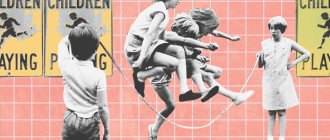Outdoor games of peoples for young children
Bykhovets L.A. Outdoor games of peoples for young children // Sovushka. 2022. N1(11). URL: https://kssovushka.ru/zhurnal/11/ (access date: 01/18/2022).
Order No. 76321
APPENDIX: Long-term plan for introducing young children to folk outdoor games
"Give the children more and more
content of the general, human,
global, but mainly
try to introduce them to this through
native and national phenomena"
V. Belinsky
Outdoor play is a natural companion in a child’s life, a source of joyful emotions that have great educational power.
Outdoor play is a complex emotional activity of children, aimed at solving motor problems, based on movement and the presence of rules.
Outdoor play activates breathing, blood circulation and metabolic processes, improves movements, and develops their coordination. Forms speed, strength, endurance, teaches children to act in accordance with the rules, act consciously in a changing game situation, and learn about the world around them. Activates memory, ideas, develops thinking, imagination, replenishes vocabulary and enriches children's speech. Teaches how to act in a team, obey common requirements, forms honesty, justice, discipline, teaches friendship, empathy, helping each other, develops a sense of rhythm, and promotes mastery of spatial terminology.
In the process of raising children on the ideas of folk pedagogy, a set of tasks of social-communicative, emotional-moral, cognitive-speech, physical development is solved by means of folk games:
- To develop in children an emotionally active attitude and effective interest in the games of the peoples of the Southern Urals.
- Create conditions for the manifestation of children's gaming culture.
- Enrich the child’s cognitive and speech sphere with knowledge of the rules of folk games, the foundations of the history and culture of the peoples of the Southern Urals.
- To promote the effective introduction of children to folk culture through games of the peoples of the South Ural region.
- Create conditions for the use of different types of folk games in independent, free play activities.
- Strengthen children's gaming experience based on the use of moral values of the child's interaction with adults and peers.
In early preschool age, in accordance with age characteristics and abilities, games can be used to a greater extent, such as: fun games, games with folk toys (Babinsky nesting dolls, Bogorodsk toys, insert eggs, etc.), outdoor and round dance games.
Folk outdoor games are a traditional means of pedagogy. From time immemorial, they clearly reflected the way of life of people, their way of life, work, national principles, ideas about honor, courage, courage, the desire to have strength, dexterity, endurance, speed and beauty of movements, to show ingenuity, endurance, creativity, resourcefulness, will and the desire to win.
In our country, the revival of the ancient culture of all peoples is taking place everywhere and steadily, national traditions in art and literature are developing and improving, containing the richest layers of folklore, which include folk outdoor games.
Taking into account demographic data, a large percentage of representatives of Russian, Bashkir and Tatar nationality live in the Ural region. Therefore, in our opinion, the games of these peoples must be used in the educational process of our kindergarten.
In the lives of modern children, folk games are a well-forgotten old thing, a return to normal. These games have stood the test of time.
Each nation has its own collection of games . The Russian nation is socially formative, therefore other nationalities have united around it.
The folk games of the inhabitants of the Southern Urals have a lot in common.
They were created for the purpose of raising children, entertainment (they were created for centuries).
All folk games are games with rules (the author is the people).
The games have a game beginning in the form of counting rhymes and dialogues.
The games reflect the mentality of the people, the main activities of Muslim peoples are hunting, cattle breeding, the Cossacks - border guarding.
In terms of content, all folk games are classically laconic, expressive and accessible to children.
The use of folk games helps children become acquainted with the origins of the culture of their people, with the origins of gaming culture in general.
It is necessary to systematically use folk games, adhering to the ideas of folk pedagogy, alternating games of different nationalities, alternately including moving, verbal, and round dancing.
The significance of folk games and their developmental effect is multifaceted:
- In games, folk wisdom.
- With the help of folk games, preschoolers can get acquainted with the mentality of other peoples.
- Folk games carry information about crafts.
- Respect for other peoples (tolerance)
- Bring an element of novelty into the modern culture of children
- The problem of fathers and children is smoothed out, because children don't know what their parents played.
- Therapeutic effect (pleasure)
In early preschool age, in accordance with age characteristics and capabilities, folk games, to a greater extent, can be used, such as: games with speech accompaniment (miniatures of oral folk art), fun games, games with folk toys, outdoor games, occasionally round dances.
Outdoor games are mainly collective, so children develop basic skills to navigate in space, coordinate their movements with the movements of other players, find their place in a column, in a circle, without disturbing others.
The joint actions of young children create conditions for common joyful experiences and common active activity. In collective outdoor games, children learn to play together, give in and help each other.
All games for preschool children based on movement can be divided into two large groups: plot and plotless games, and fun games. The first group consists of games that differ in content, in the organization of children, in the complexity of the rules and in the uniqueness of motor tasks. In the younger groups of kindergarten, plot-based outdoor games are most used, as well as simple games without a plot, such as traps and fun games. Plotless games with elements of competition are not yet available to children. At the same time, when working with children of primary preschool age, play exercises are widely used, occupying an intermediate place between gymnastic exercises and outdoor games.
Games of this type are based on the experience of children, their ideas and knowledge about the surrounding life, natural phenomena, the lifestyle and habits of animals and birds.
Some features of animal behavior (the cunning of a fox, the habits of predators - wolves, pikes, the speed of movements of hares, birds, the caring nature of a hen, etc.) serve as the basis for developing the plot and establishing the rules of the game.
The plot of the game and the rules determine the nature of the movements of the players. In one game, kids, imitating horses, run, raising their knees high, in another game they jump like bunnies, etc. In story games, therefore, the movements performed are of an imitative nature.
Children begin, stop, or change movements in accordance with the rules of the game, which are usually closely related to the plot and determine the behavior and relationships of the players. In some story games, the actions of the players are determined by the text (“Bear the Bear in the Forest,” “Geese and Swans,” “Hares and the Wolf,” etc.).
In story games, usually the majority of children portray, for example, birds, bunnies, and one child or teacher becomes the performer of a responsible role - a wolf, a fox, a cat. Children's actions are closely interconnected. Thus, the activity of a child playing the role of a wolf encourages the other participants in the game - the hares - to move faster and more energetically. This constitutes children's play actions. However, each child, when playing, demonstrates independence, initiative, speed and dexterity to the best of his abilities.
Since in the games of this group a group of children acts, obeying the rules, this largely determines their behavior and relationships. Kids are accustomed to coordinated collective actions in certain conditions, learn to change the method and nature of movements according to signals and in accordance with the rules. For example: birds quickly fly away to their nests as soon as it starts to rain, etc.
Thematic outdoor games are widely used in all age groups of kindergarten. However, they are especially popular in early age groups.
Plotless folk outdoor games such as traps and dashes are very close to plot ones - they just don’t have images that children imitate, all other components are the same: the presence of rules, responsible roles (traps, tags), interconnected game actions of all participants. These games, like the plot ones, are based on simple movements, most often running combined with catching and hiding, etc. Such games are accessible to young children.
Purpose: physical activity is a factor influencing a healthy lifestyle. Development of attentiveness, dexterity, speed of motor reaction, strengthening of the muscles of the musculoskeletal system. Creating conditions for children to develop elementary ideas about the culture and traditions of peoples through outdoor play.
Tasks:
- Formation in children of a holistic attitude towards national culture, traditions and games of peoples; contribute to the strengthening of family ties, through interest in outdoor games, not only of children, but also of their parents.
- To form an idea of the variety of folk games; learn to use folk games in independent activities, act according to the rules; broaden children's horizons.
- To promote the development of children's creative abilities and the desire to learn more about their native land.
- Develop different types of memory.
- Develop communication skills and the emotional sphere of the child.
- Develop mental operations through play.
- Develop imagination.
- Learn to relieve emotional stress through games
Literature:
- Babunova E., Gradusova L. Levshina N., Lopatina E., Obukhova S., Turchenko V. Our home is the Southern Urals: a software and methodological complex for organizations implementing educational programs for preschool education. Chelyabinsk: Chelyabinsk regional branch of the Russian Children's Fund, 2014.
- Adaptation of young children to the conditions of a preschool educational institution: A practical guide /author-comp. Belkina L.V. Voronezh: Teacher, 2004.
- Vinnikova G.I. Classes for children 2-3 years old: first steps in mathematics, development of movements. M.: TC Sfera, 2009.
- Kuznetsova A.E. The best educational games for children from one to three years old. M.: ID RIPOL classic, HOUSE. XXI century, 2006.
- Pavlova P.A., Gorbunova I.V. Grow healthy, baby! Early childhood health program. M.: TC Sfera, 2006.
- Strakovskaya V.L. 300 outdoor games for the health of children from 1 year to 14 years. M., 1994.
- Shishkina V.A. Movement + movement. M., 1992.




